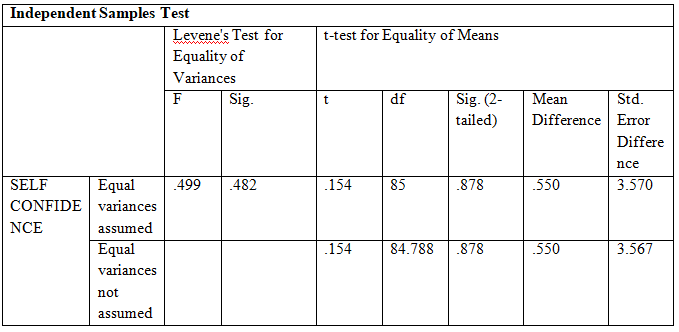A COMPARATIVE STUDY OF SELF-CONFIDENCE LEVEL BETWEEN MALE AND FEMALE INTERCOLLIGIATE FOOTBALL PLAYERS FROM GOA
Abstract
Abstract
Having sports confidence means having self-confidence which is YOUR belief in YOUR ability to complete a physical skill or task required in your sport. The aim of these study was to compare the self confidence level between male and female intercollegiate football players from Goa state. For this purpose a sample size 80 respondents were selected which consisted of 40 male football players and 40 female football players who played at intercollegiate level. For these study random sampling technique was used. The data was collected through a questionnaire prepared using google forms. The collected data was analyzed using Vealey's trait sport confidence Inventory and independent T test was used. The questionnaire consisted 13 questions of a 9point Likert scale ranging from 1= lowest, 5= medium and 9= highest self- confidence. The result revealed that there is no mean significance difference in the self confidence level between male and female intercollegiate football players from Goa. It can be concluded that the confidence level in female can increased through family motivation and support.
Downloads
References
https://psycnet.apa.org/record/2007-07146-029
Lenney and Ellen (1977). Women's self confidence in achievement settings. Psychological bulletin, 84(1), 1-13. Retrieved on 24/05/21 from
https://psycnet.apa.org/journals/bul/84/1/1/
Vealey, R.and Chase (2008). Self -conditions in sports. Advances in sports psychology, 68-97, 430-435. Retrieved on 24/05/21 from
https://psycnet.apa.org/record/2008-01583-005
Sheldon, Stephen and Ross (2004). Self- confidence and anxiety interpretation: A qualitative investigation. Psychology of sport and exercise, 5(4), 477-495. Retrieved on 24/05/21 from
https://www.sciencedirect.com/science/article/pii/S1469029203000402
Sabina and Lazar (2007). Self- confidence and metacognitive processes. Learning and individual differences, 17(2), 161-173. Retrieved on 24/05/21 from
https://www.sciencedirect.com/science/article/pii/S1041608007000349
Patricia (2011). Concept analysis: confidence/ self- confidence. Nursing forum, 46(4).218-230. Retrieved on 24/05/21 from
https://onlinelibrary.wiley.com/doi/abs/10.1111/j.1744-6198.2011.00230.x.
Luke, Ngo and Tom (2014). Self- confidence and the ability to influence. Academy of marketing studies journal 18(2), 169. Retrieved on 24/05/21 from
https://psycnet.apa.org/record/1963-03052-001















